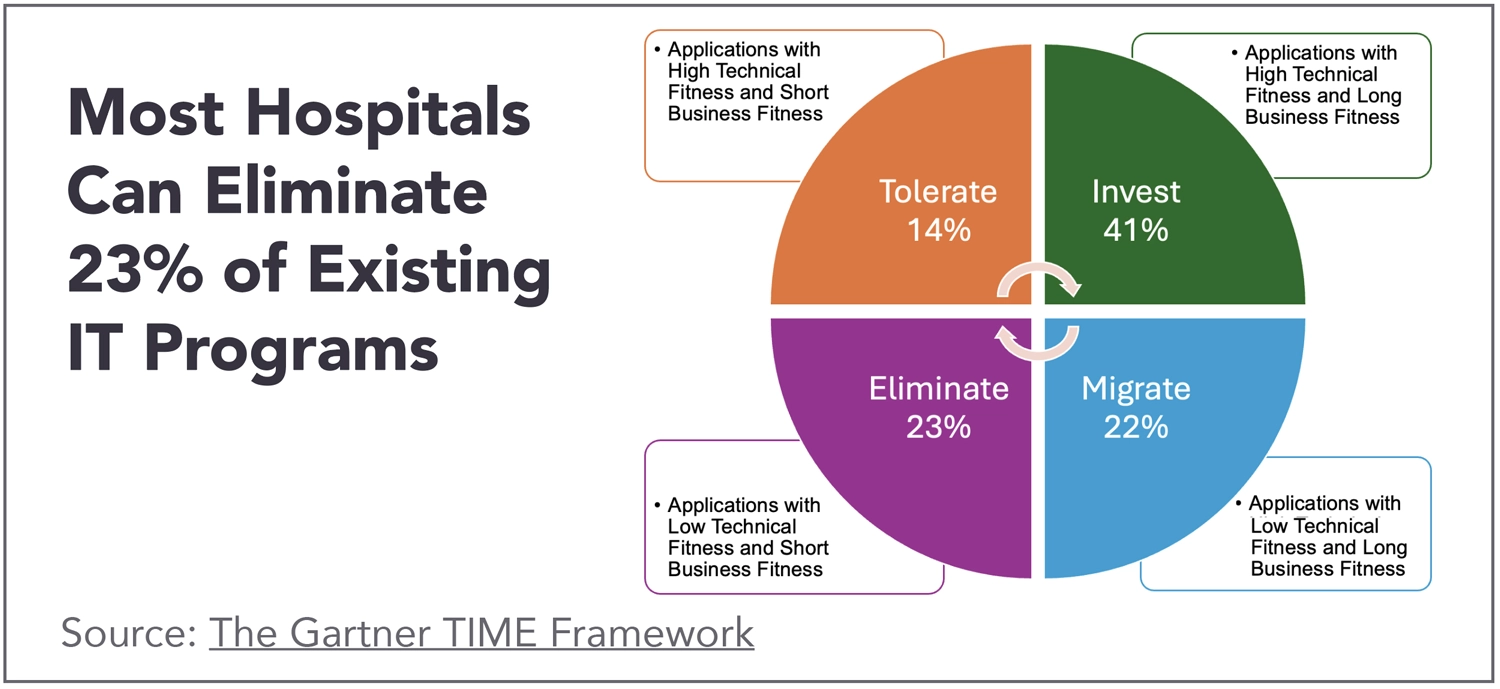U.S. hospitals are facing a cash crisis. Median days cash on hand dipped to a 10-year low, according to an August 7 S&P Global Ratings report, as reported in Becker’s Hospital CFO Report.
For the first time in a decade, the lower half of U.S. non-profit acute healthcare providers reported only 128 days of cash on hand, on average. Meanwhile, operating expenses are growing (up 8.8% last year). This double bind is not a problem limited to a few hospitals in a few parts of the country. By the end of 2022, over half of U.S. hospitals faced a financial operating loss.
To shore up their balance sheets, hospitals are looking for cash savings and many are targeting their IT areas.
Hospital IT Savings Begin with Application Rationalization, Potentially Eliminating 23% of Outdated Programs
CEOs and CFOs are asking their IT areas to undergo application rationalization, an IT process that helps cut costs and improve efficiency.
Application rationalization:
- Cleans up outdated systems, which are archived and decommissioned.
- Updates IT applications that will make operations more efficient and reduce manual processes. This bucket includes beefing up patient interfaces for self-scheduling, appointment reminders and virtual care, thus opening up staff time for less administrative burden and more patient-interface time.
- Integrates disparate systems that are the result of recent mergers or acquisitions or looks for opportunities to separate and divest systems following a sell-off of certain services.
- Reviews and enhances cybersecurity to sidestep threats and preserve patient confidential information, meeting data protection and privacy standards.
Innovative estimates that the average hospital can safely eliminate 23% of existing IT programs (see chart).

With IT Cleanups, Hospital Organizational Savings Occur on Many Levels
The savings from application rationalization and then from implementing necessary improvements can be quantified in several ways. First, by eliminating redundant applications and following best practices, Gartner estimated in 2016 (and Healthcare IT Today reaffirmed in 2020) that companies can reduce total cost of ownership by 30%. Given that application costs are estimated to make up 80% of the entire IT budget, those can be significant savings.
Some of the IT savings should be invested in new technologies, because these new investments can save money, too. One such area of tech investment is AI. According to Forbes, AI could shave healthcare costs by $80 to $110 billion over the next five years, and physician groups could save between 3% and 8% of their costs, representing an additional $20 to $60 billion in savings.
The savings are partly from having more efficient systems, but also from avoiding other liabilities by implementing new and robust systems. Healthy IT systems help hospitals avoid data breaches, which cost hospitals an average of $9.77 million in 2024, according to the Department of Health and Human Services Office for Civil Rights. In 2022, one out of every 42 healthcare organizations was the victim of a ransomware attack.
How to Select the Right Application Rationalization Vendor
At Innovative, we approach rationalization from a broad perspective, keeping in mind the importance of EHR optimization, interoperability and systems integration, ERP optimization, and revenue cycle management.
The best application rationalization vendor is one with industry knowledge (that preferably focuses on healthcare alone), a well-defined approach, technical capabilities that can scale to your needs, and a pricing model that supports your value equation.
Look for vendors that provide adequate training for your team on their tools and methodologies.

